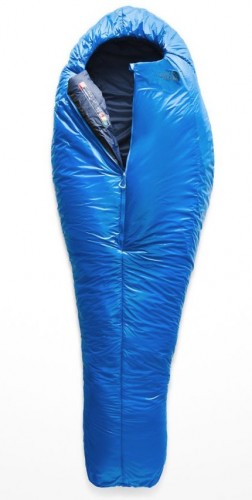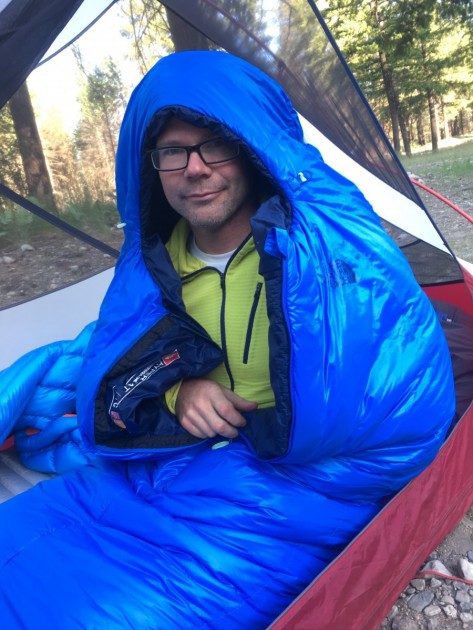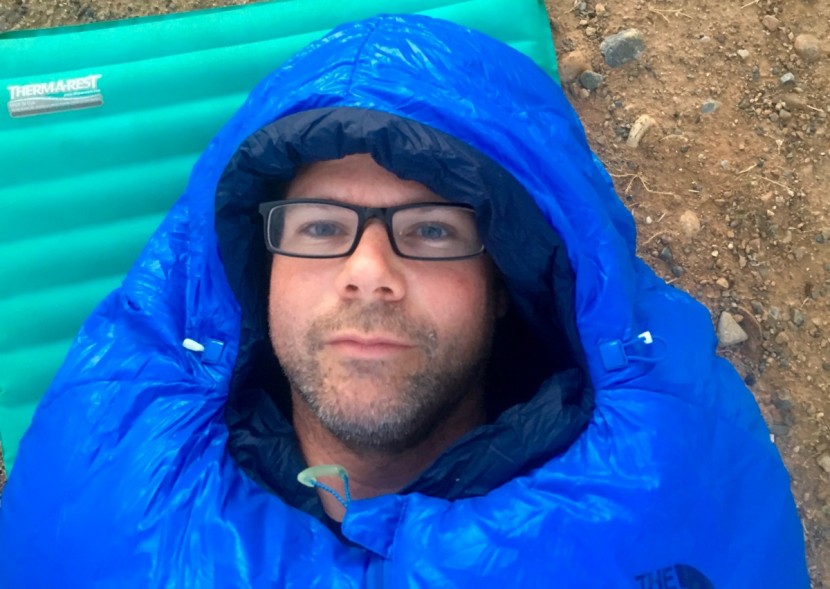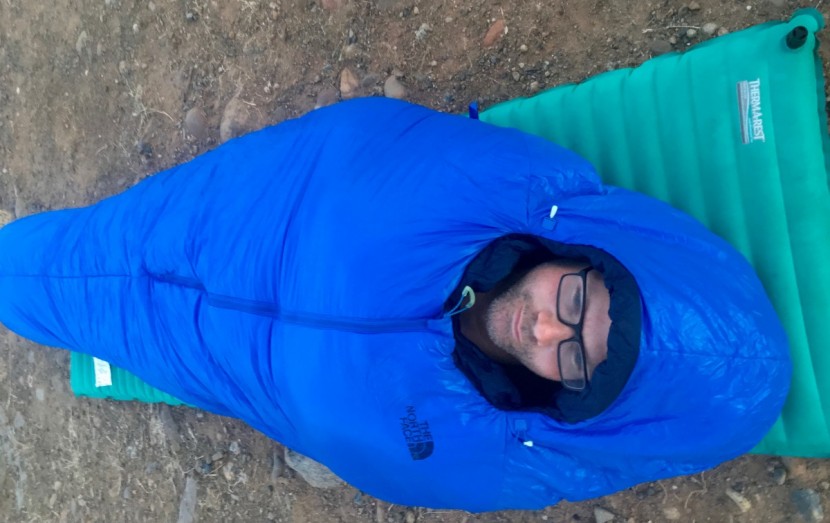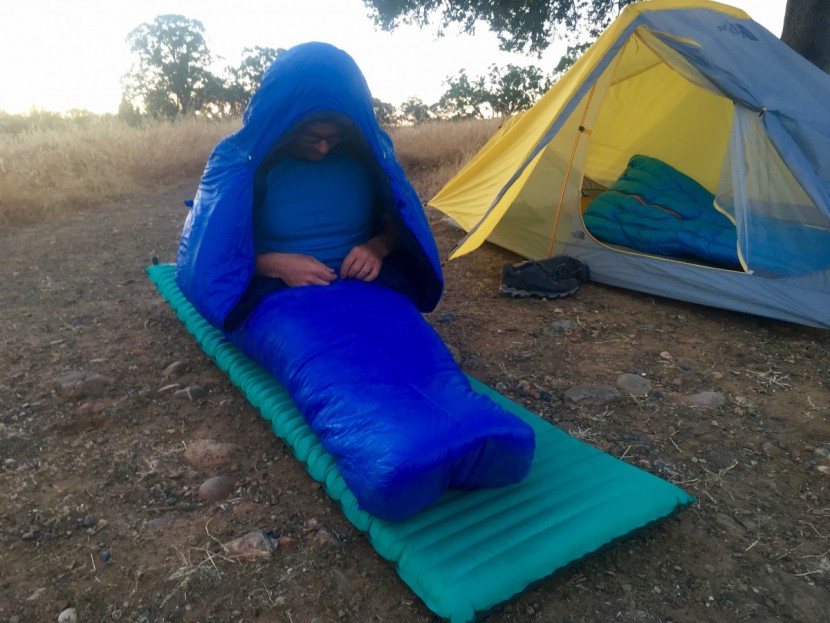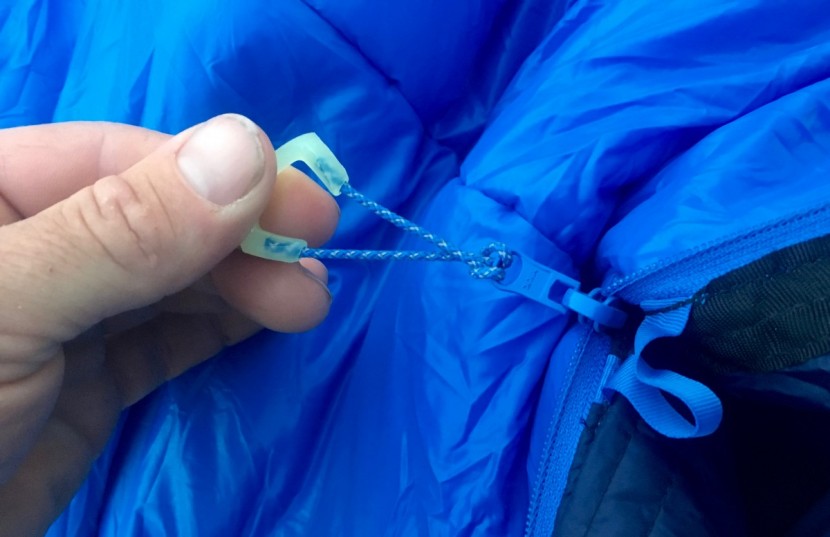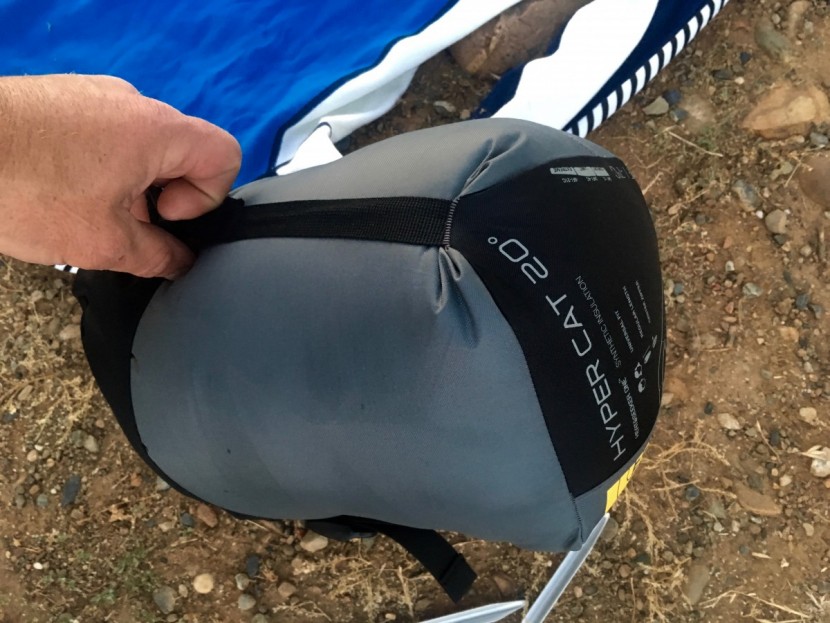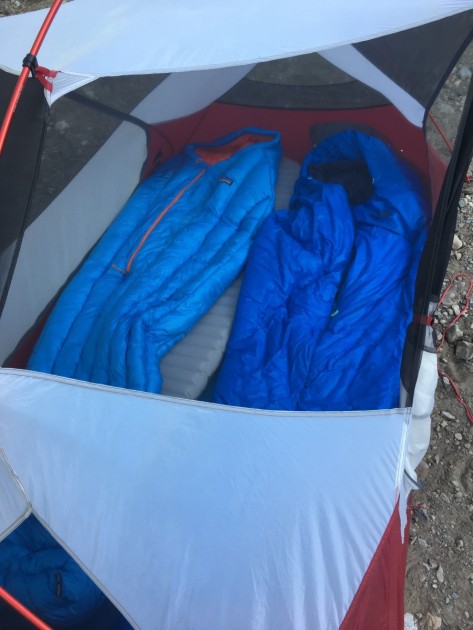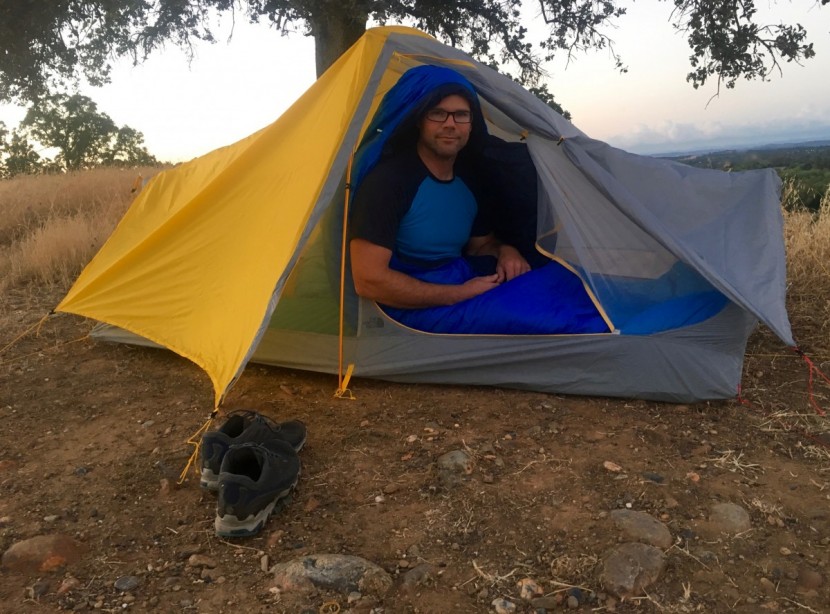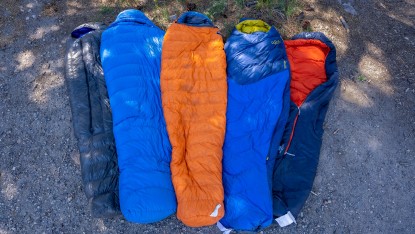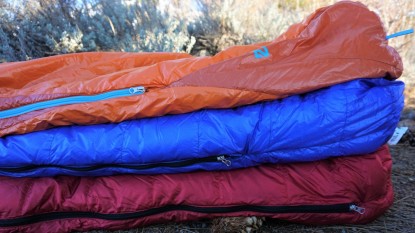The North Face Hyper Cat 20 Review

Our Verdict
Our Analysis and Test Results
Like the idea of a synthetic bag's insulation properties when wet as well as its ability to dry quickly but don't like most non-down's characteristics of being bulky and heavy? Well the Hyper Cat is the lightest and most compressible synthetic bag we have ever seen for its temperature rating and it is even comparable to lesser quality down models.
Warmth
The Hyper Cat's slightly narrower-than-average cut, particularly in the legs, helped with this bag's efficiency and overall warmth.
The Hyper Cat also sports one of the best hoods in our review. This bag uses a relatively unique construction by vertically wrapping the layers of synthetic insulation around the bag and sandwiching loose and more compressible insulation in between continuous layers; this saves weight by reducing stitching. According to the North Face, this bag uses less insulation to achieve the same warmth as comparable models. This construction method also reduces cold spots, as there is no stitching to compress the insulation.
The Hyper Cat does use noticeably less insulation on the bottom half of the bag (this saves weight). While this is a common strategy used by many sleeping bag manufacturers, it is even more apparent with this bag, because there is only a minimal amount of insulation on the Hyper Cat's lower half. However, all of our reviewers felt fine in this bag during our testing, which featured several nights of temperatures around 30F (with a sleeping pad of course). In those conditions, we never found that the bag didn't have the ability to keep us warm. Compared to the mega classic The North Face Cats Meow, the Hyper Cat is close in terms of warmth, but the Cats Meow is undeniably warmer.
After several weeks in this bag, most of our testers thought it performed well to 30° F, okay at 25° F, and was a little on the cold side at 20° F. Our review staff commented that most folks will certainly need to layer up while using this bag in temperatures below 25° F. The Hyper Cat is warmer than the Mountain Hardwear Hyperlamina Spark 35, but was bested by most of the other contenders in our review, feeling the most similar, in terms of warmth, to the REI Ingeo.
Weight
The Hyper Cat tips the scales at 1 lb 14 oz (850 g) which is one of the lightest 20F synthetic bags currently available. The North Face did a great job with the design, which works to minimalize weight without sacrificing much in the way of functionality or warmth. The Hyper Cat uses a 1/2 length zipper and far less insulation on its lower half, which is a unique design used to reduce weight.
Compared to the recently updated Cats Meow (2lbs 5 oz), the Hyper Cat is half of a pound lighter and remains far lighter than most similarly rated models. Even compared to high-end synthetic bags, the Hyper Cat is nearly the same weight as the 35° F Mountain Hardwear Hyperlamina Spark 35. When looking at 600-700 fill-power down models, like the REI Co-op Igneo 25 and Western Mountaineering UltraLite, the Hyper Cat remains a reasonably weighted bag.
Comfort
A slightly slimmer-than-average cut means “less comfort” for many people, but this bag was hardly catastrophically tight; just slimmer than average. It is worth noting that the hips and leg area were pretty slim but the shoulder area was average, helping the bag to feel less snug.
The internal fabric was top notch, and easily the best and most cozy feeling of any synthetic bag we tested. Though we aren't completely sure on the reasoning, our testing team felt that the Heatseeker insulation regulated our temperature better than most other synthetic insulations we tested.
Despite some early skepticism, the center zip was an added bonus; many people in our testing team were wary, particularly ones that got hot easily and wanted the ability to vent. After more than a week of use, our testing team loved the front center zip. We did not experience any discomfort and did not feel like it created any sort of disadvantage from a comfort perspective while sleeping. The center zip design was more comfortable when sitting up, cooking, playing cards, or just generally hanging out.
Why don't all sleeping bags feature this front zipper? This design doesn't allow for the same level of ventilation and temperature regulation that a full-length side zip bag offers. Not only does a full-length side zipper offer more ventilation but it generally allows the user to find a better balance of temperature regulation. The front zip, while more comfortable to sit up when using, is sort of all-or-nothing feature when it comes to temperature regulation; it can leave its users feeling cold quickly if it gets unzipped too far.
Versatility
The Hyper Cat is good at what it's designed to do, which is to perform well on technical adventures. This contender is ideal for any trip where a synthetic bag is desired, but volume and weight remain at a premium. Its slender cut, half-length front zipper, and minimally insulated lower half won't cause any significant issues. The half-length zipper doesn't allow for first-rate temperature regulation when compared to models with full-length side zippers. While the half-length zipper is great to hang out in, it's all-or nothing when it comes to venting and managing the internal temperature of the person using the bag. During certain temperature ranges, if we left the bag unzipped, the part of our body exposed to the opening would get cold; when we zipped the bag all the way up, we were a little too warm.
While this bag is slimmer-than-average, the dimensions of its torso area are closer to average and the vast majority of users will be able to add layers, which will extend this bag's temperature range. Another point worth noting is our testers thought that the insulation in the Hyper Cat, referred to as Heatseeker Pro, regulated the user's temperature slightly better than most of the synthetic bags we tested. So while this model is not as great for lots of activities or huge temperature ranges, the Hyper Cat's low weight and minimal packed volume helps the bag perform well at activities which prioritize those qualities.
Packed Size
The Hyper Cat packs extremely small for a synthetic bag and is roughly the same size as the REI Co-op Igneo 25. It is nearly as small as the 35° F Mountain Hardwear Spark 35 and comes with a storage sack and an included compression sack. While it might be slightly heavier than most aftermarket models, it did a good job of optimizing the Hyper Cat's compressed size.
Features & Design
The sweet center half-length zipper is nice for hanging out in around the fire or for performing chores in, like cooking or cleaning up; however, it doesn't offer as effective of a way to regulate temperatures. For technical use, specifically alpine or big wall climbing, this feature rocked.
The center zipper features a second (inside only) two-way zipper which helped facilitate being in the bag while staying clipped into your harness via a rope or daisy chain. This was particularly wonderful for hanging out in inside the sleeping bag while kicking it on the Portaledge cooking. As a result, this is our new favorite big wall sleeping bag.
The other small but sweet feature was the glow-in-the-dark zipper pull, which we found far more useful than originally anticipated. It certainly proved to be one of those features that you never knew you wanted until you had - and then you're left wondering now why all sleeping bags don't have it.
The HeatSeeker One synthetic fabric used in the Hyper Cat is extremely lightweight and compressible, but that comes at a slight durability cost. We think that over time, the HeatSeeker One insulation is slightly less durable than other synthetic fabric from a longevity standpoint and will likely lose some of its overall warmth after around five years of use.
Hyper Cat Versus Treated Down Bags
When we did our untreated down versus non-treated down comparisons, there was a some, though still a fairly minimal amount of difference in water-resistance and drying times. However, during our testing, all of the synthetic fabrics were far more water resistant and offered significantly quicker drying times overall on average, drying in about 20% of the time as treated hydrophobic down bags that we tested (during our complete soaking test).
Best Applications
In all reality, the new Hyper Cat is probably the best synthetic bag for 3+ season use that we have ever seen. Each tester who used this bag was absolutely impressed by how light and compact it was for a synthetic model, especially considering its 20° F rating. For someone who car camps more times than backpacks, we'd likely go with the wider cut North Face Cats Meow because of its more comfortable dimensions and full-length zipper.
Value
At $240, the Hyper Cat is the same price as many down bags with 700+ or lower down fill power - all while being comparable in weight and packed size, even occasionally being smaller. The disadvantage of using a synthetic bag (versus down) comes down to their longevity. While this model is initially comparable in price and performance to many of the down bags in our review, it won't last as long simply because synthetic fibers break down far quicker, thus losing their warmth over time.
Conclusion
This is our new favorite 3-season synthetic bag for its weight and compressed volume. While we generally prefer down for most backpacking and mountaineering trips, we almost always reach for a synthetic bag for wet coastal hikes, kayaking adventures, and big wall climbing. As a result, if you want a synthetic bag for the climate/conditions you're traveling in, want to support ethical animal rights, or have allergies to down, and you want one of the highest performing synthetic bags out there, the Hyper Cat is certainly for you.


